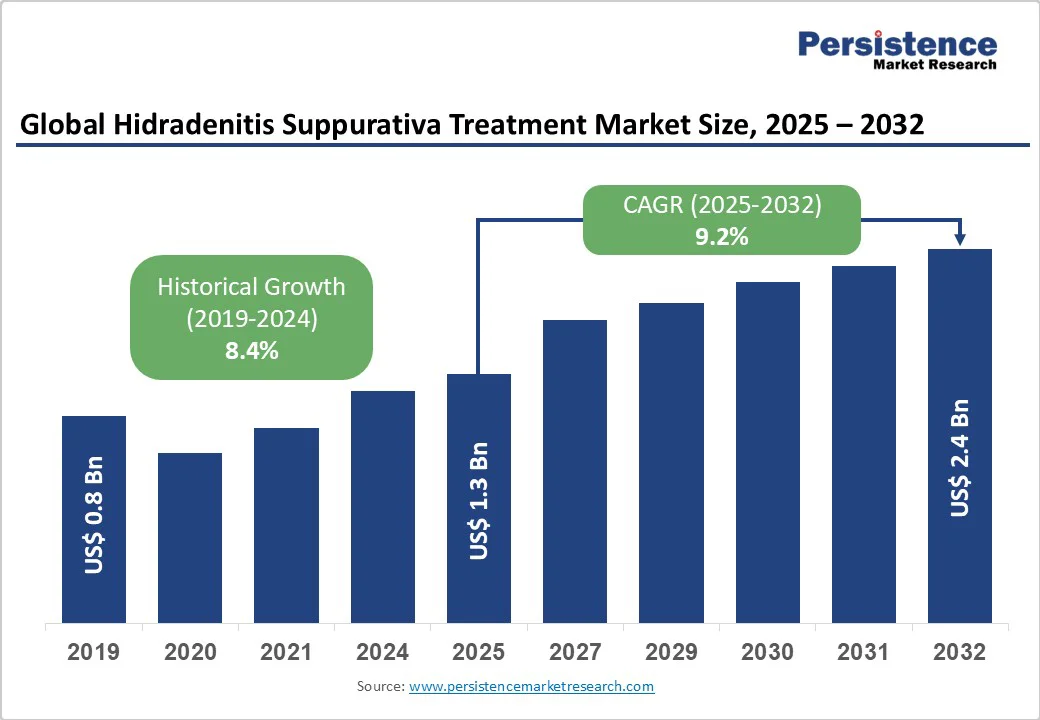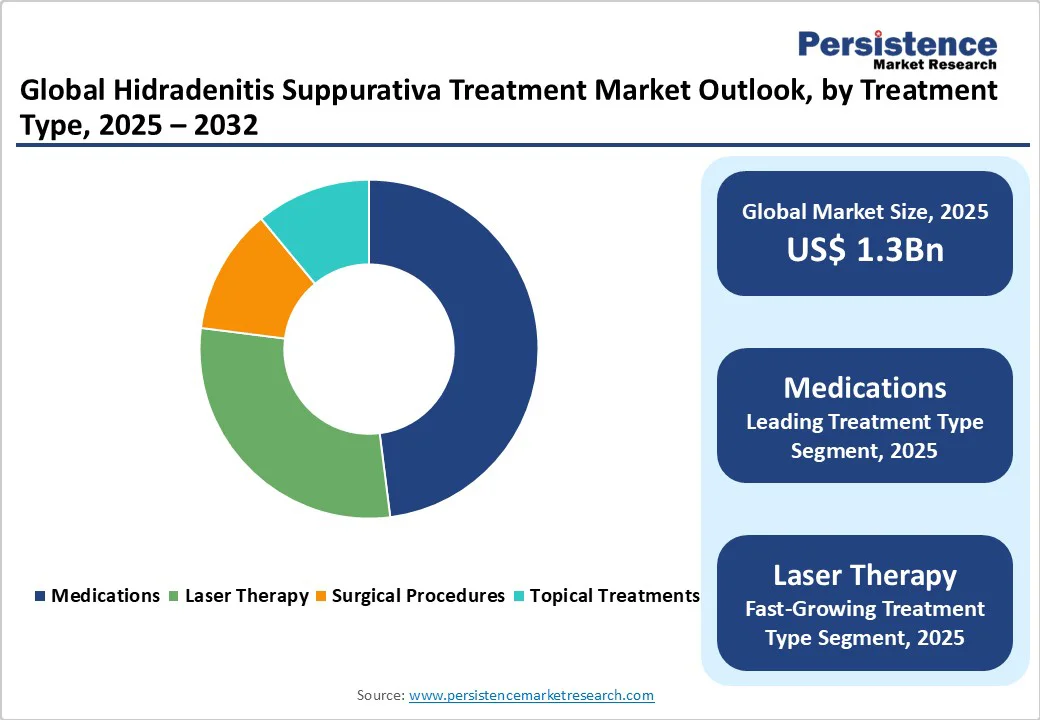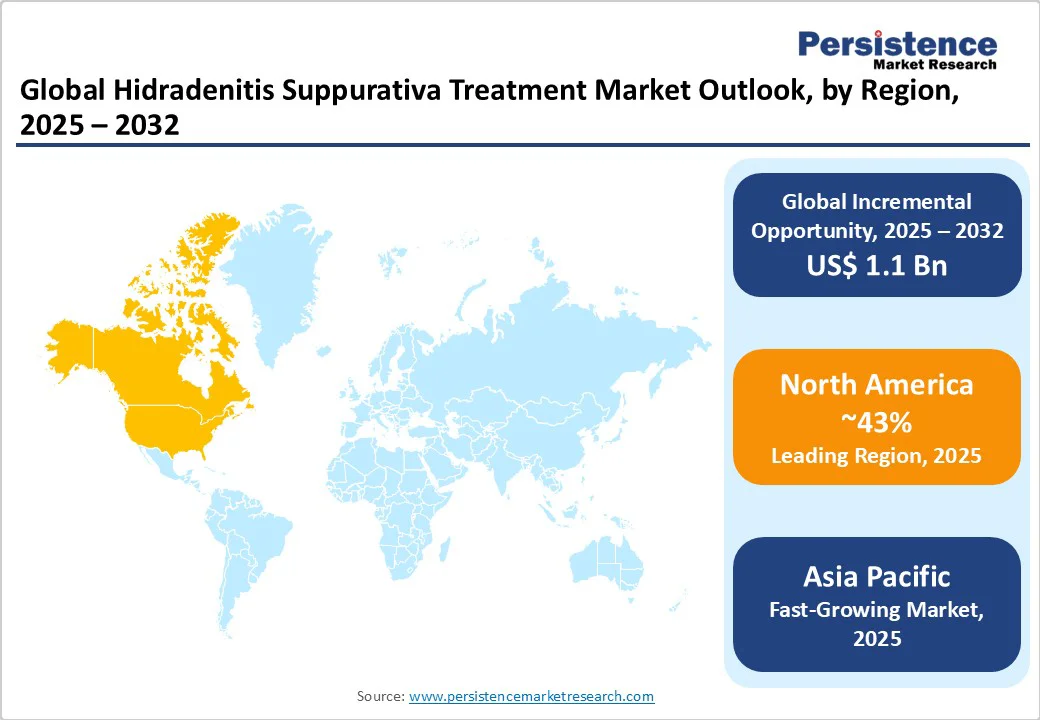ID: PMRREP31202| 189 Pages | 29 Sep 2025 | Format: PDF, Excel, PPT* | Healthcare

The global hidradenitis suppurativa treatment market size is likely value at US$ 1.3 Bn in 2025 and is expected to reach US$ 2.4 Bn by 2032, growing at a CAGR of 9.2% during the forecast period from 2025 to 2032, driven by increasing awareness of the chronic skin condition, advancements in biologics and targeted therapies, and the rising prevalence of HS globally.
| Key Insights | Details |
|---|---|
| Hidradenitis Suppurativa Treatment Market Size (2025E) | US$ 1.3 Bn |
| Market Value Forecast (2032F) | US$ 2.4 Bn |
| Projected Growth (CAGR 2025 to 2032) | 9.2% |
| Historical Market Growth (CAGR 2019 to 2024) | 8.4% |

The rising prevalence and growing awareness of hidradenitis suppurativa are key drivers. HS is a chronic inflammatory skin disorder characterized by painful nodules, abscesses, and scarring, often affecting the armpits, groin, and under the breasts.
Increasing epidemiological studies and better diagnostic practices have led to higher reported prevalence rates worldwide, particularly in North America and Europe. Enhanced awareness among healthcare professionals and patients has resulted in earlier diagnosis, improved disease management, and a greater demand for effective treatments.
For instance, the Hidradenitis Suppurativa Foundation (HSF) in the U.S. runs awareness campaigns and educational programs for both patients and clinicians, promoting early recognition of symptoms and encouraging timely consultation with dermatologists.
The high costs associated with HS treatments, particularly biologics and surgical interventions, pose a significant restraint on market growth. HS is a chronic and often severe condition that requires long-term management, including biologic therapies, surgical interventions, and combination treatments, which can be expensive.
Biologics such as adalimumab (Humira) and infliximab are effective in controlling moderate to severe HS but come with high price tags, limiting patient access, especially in developing regions or among the population without adequate health insurance coverage. The need for frequent clinical consultations, monitoring, and follow-up care further adds to the financial burden for patients.
Access to specialized dermatology centers and trained healthcare providers is uneven across regions. In rural or underserved areas, patients often face delays in diagnosis and treatment initiation, which can aggravate disease progression and reduce treatment efficacy.
For instance, in countries such as India and parts of Southeast Asia, biologic therapies are available only in major urban hospitals, making them inaccessible for a large portion of patients in rural regions. These financial and accessibility challenges limit market growth by restricting the number of patients who can afford or reach advanced HS treatments, highlighting the need for affordable therapies and broader healthcare infrastructure expansion.
Advancements in biologic and targeted therapies present a significant opportunity for growth in the hidradenitis suppurativa treatment market. HS is a chronic inflammatory skin condition that often requires long-term management, and conventional treatments such as antibiotics or corticosteroids may provide only limited relief.
Biologics and targeted therapies, including tumor necrosis factor (TNF) inhibitors such as adalimumab and interleukin (IL) inhibitors such as secukinumab, offer precise mechanisms of action to control inflammation, reduce flare-ups, and improve patients’ quality of life.
These therapies address the unmet medical needs of moderate to severe HS cases, expanding treatment options and encouraging wider adoption of advanced care. For instance, the FDA-approved biologic adalimumab (Humira) has transformed HS management by demonstrating significant reductions in lesion counts and symptom severity, leading to increased patient adherence and long-term treatment outcomes.
Ongoing research and clinical trials are introducing new targeted therapies that aim to provide better efficacy, safety, and patient convenience, including subcutaneous formulations and combination approaches. These innovations are expected to drive market expansion, attract investment, and stimulate further R&D, creating opportunities for both established pharmaceutical companies and emerging biotech firms.
Biologics dominate the Hidradentitis Suppurativa Treatment market, expected to account for approximately 52% share in 2025. Their dominance stems from their targeted efficacy in managing moderate to severe HS cases, particularly through drugs such as adalimumab, which inhibit tumor necrosis factor-alpha (TNF-α).
Biologics offer superior symptom control and reduced flare-ups compared to traditional therapies, making them a preferred choice for dermatologists and patients with Hurley Stage 2 and 3 HS. Companies such as AbbVie and Johnson & Johnson lead this segment by providing innovative biologic solutions that enhance patient outcomes.
Oral antibiotics are the fastest-growing segment, driven by their widespread use in managing mild to moderate HS cases and their affordability compared to biologics. Antibiotics such as clindamycin and rifampicin are commonly prescribed for their anti-inflammatory and antibacterial properties, addressing secondary infections associated with HS. The growing focus on early intervention and combination therapies, particularly in regions with limited access to biologics, is accelerating the adoption of oral antibiotics.
Medications lead the Hidradentitis Suppurativa treatment market, accounting for a 48% share in 2025. This segment’s dominance is driven by the widespread use of biologics, oral antibiotics, and corticosteroids for symptom management and flare-up prevention.
Medications streamline HS treatment by addressing both inflammatory and infectious components of the condition, making them critical for both acute and chronic care. Key players such as GlaxoSmithKline and Merck are investing in novel drug formulations to enhance efficacy and patient compliance.
Laser therapy is the fastest-growing segment, fueled by its increasing adoption for managing chronic HS cases and reducing scarring. Laser treatments, such as CO2 laser and Nd: YAG laser, offer non-invasive options for removing affected tissue and promoting skin healing. The rise in demand for aesthetic outcomes and minimally invasive procedures, particularly in developed regions such as North America and Europe, is driving rapid adoption.
Hospitals hold the largest market share, accounting for approximately 50% of revenue. Hospitals serve as primary care centers for severe HS cases, offering multidisciplinary treatment involving dermatologists, surgeons, and wound care specialists.
Their ability to provide advanced interventions, such as surgical procedures and biologic administration, makes them critical for managing complex HS cases. Hospitals also benefit from established relationships with pharmaceutical companies such as Pfizer and Allergan, ensuring access to cutting-edge therapies.
Dermatology clinics are the fastest-growing segment, driven by the increasing demand for specialized HS care and outpatient treatment options. These clinics offer tailored solutions, including biologics, laser therapy, and topical treatments, catering to patients seeking personalized care. The rise in dermatology-focused healthcare infrastructure, particularly in urban areas of the Asia Pacific and Europe, is accelerating adoption.

North America is the dominant region in the global hidradenitis suppurativa treatment market, with a 43% market share. The region’s growth is primarily driven by robust healthcare infrastructure, high awareness of HS among both patients and healthcare professionals, and widespread adoption of advanced biologic therapies.
The presence of well-established hospitals, specialized dermatology clinics, and efficient distribution networks ensures that patients have access to innovative treatments, including TNF inhibitors such as adalimumab and interleukin inhibitors.
Research and development (R&D) activities in the U.S. are also a key factor propelling market growth. Leading pharmaceutical and biotech companies are actively engaged in developing next-generation biologics, targeted therapies, and combination treatment approaches that improve efficacy, safety, and patient adherence.
Regulatory support from agencies such as the FDA, combined with high healthcare spending, enables faster approvals and commercialization of novel therapies, further strengthening North America’s market position.
Patient awareness campaigns, advocacy programs, and the prevalence of clinical trials in the region facilitate early diagnosis and timely intervention, enhancing treatment outcomes. Collectively, these factors establish North America as both the largest and most advanced market for HS therapies, providing a strong foundation for continued innovation and growth in the coming years.
Europe is emerging as a significant player, supported by strong healthcare systems and collaborative research initiatives. Leading countries, including Germany, the UK, and France, drive market growth through extensive investments in dermatological research and advanced treatment facilities.
The European Medicines Agency (EMA) plays a pivotal role in approving new HS therapies, fostering innovation in biologics and laser treatments. Companies such as GlaxoSmithKline and AstraZeneca are leading the development of novel therapies, catering to both hospital and outpatient settings.
The region’s focus on universal healthcare and subsidized treatment costs enhances access to advanced therapies, particularly biologics. Germany, with its advanced dermatology clinics, leads in outpatient HS care, while the UK’s National Health Service (NHS) supports widespread access to medications and surgical interventions.
The growing emphasis on personalized medicine and the integration of AI-driven diagnostics are further strengthening Europe’s market position. Additionally, increasing awareness of HS through patient advocacy groups and medical conferences is driving demand for specialized care, ensuring steady market growth in the region.
Asia Pacific is the fastest-growing market for HS treatment, driven by rapid advancements in healthcare infrastructure and increasing awareness of dermatological conditions. Countries such as China and India are leading the region’s expansion, with China investing heavily in healthcare modernization and India expanding access to specialized dermatology care. The rising prevalence of HS, coupled with growing obesity rates and lifestyle changes, is driving demand for effective treatments in these countries.
Government initiatives, such as India’s Ayushman Bharat scheme, are improving access to healthcare services, including dermatology care, in rural and underserved areas. Similarly, China’s focus on expanding hospital and clinic networks is enhancing the availability of biologics and laser therapies. The increasing adoption of telemedicine and digital health platforms is also facilitating early diagnosis and treatment, particularly in remote regions.
Private players and pharmaceutical companies such as Merck and Pfizer are investing in the region, leveraging cost-effective manufacturing to deliver affordable therapies. With supportive policies, rising healthcare expenditure, and growing patient awareness, the Asia Pacific is expected to dominate the market growth in the near future.

The global hidradenitis suppurativa treatment market is moderately consolidated, dominated by pharmaceutical giants such as AbbVie, Johnson & Johnson, Merck, and Pfizer, alongside smaller, fragmented regional biotech firms. In North America and Europe, leading companies leverage advanced R&D, extensive product portfolios, and partnerships with dermatology clinics to develop biologics and targeted therapies.
In the Asia Pacific, rising HS prevalence and growing healthcare access attract both international and local players. Companies focus on innovative biologics, oral therapies, and precision medicine, while strategic collaborations, acquisitions, and patient awareness initiatives enhance adoption. Competition is driven by pipeline expansion, product innovation, and regional growth strategies.
The global hidradenitis suppurativa treatment market is projected to reach US$ 1.3 Bn in 2025.
The rising prevalence and awareness of Hidradenitis Suppurativa are key drivers.
The hidradenitis suppurativa treatment market is poised to witness a CAGR of 9.2% from 2025 to 2032.
Advancements in biologic and targeted therapies are a key opportunity.
GlaxoSmithKline, Johnson & Johnson, Merck, Pfizer, AbbVie, Allergan, and AstraZeneca are key players.
| Report Attribute | Details |
|---|---|
| Historical Data/Actuals | 2019 - 2024 |
| Forecast Period | 2025 - 2032 |
| Market Analysis | Value: US$ Bn, Volume: As Applicable |
| Geographical Coverage |
|
| Segmental Coverage |
|
| Competitive Analysis |
|
| Report Highlights |
|
By Drug Type
By Treatment Type
By End-use
By Region
Delivery Timelines
For more information on this report and its delivery timelines please get in touch with our sales team.
About Author